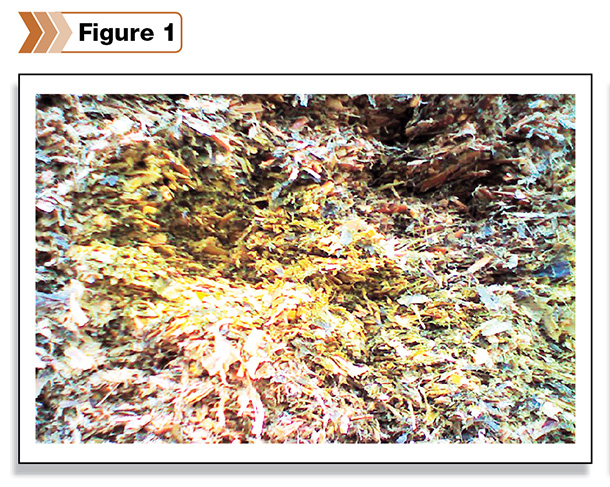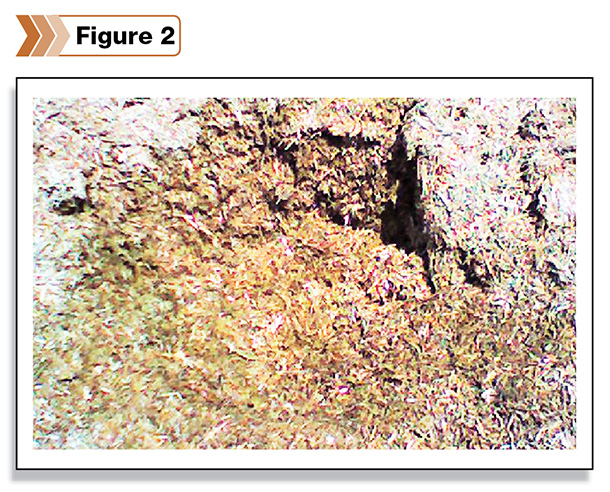The best way to evaluate the quality of silage is by sampling it appropriately and requesting both fermentative and nutritive analyses from an accredited analytical laboratory. In addition, the laboratory can also identify and quantify the microbial populations present in the sample, as well as the presence and concentrations of mycotoxins.
However, running the full slate of analyses from the nutritional profile through to mycotoxins can be expensive.
There are some clues that can be drawn about what happened during the fermentation from the appearance of the silage and what it smells like.
This article will discuss what these sensory indicators can mean in terms of silage quality and hygiene.
Sweet smells
There is an open assumption that silages with a fruity or sweet odor are synonymous to a well-fermented, stable feed. This is not usually the case since this smell is often due to high alcohol (ethanol) concentrations that are produced mainly by yeasts but also some types of bacteria.
The alcohol may react with acids in the silage, producing esters and adding to the fruity aroma. Since yeasts are the main cause of heating events in silages when exposed to air, these fruity-smelling silages can actually be quite unstable at feedout.
Corn silage and high-moisture corn are more susceptible to this heating due to yeast growth at feedout, which can lead to significant losses of dry matter (DM), energy and nutrients.
Moldy smells
Silages that are aerobically unstable may also present a musty or moldy smell, and may have visible mold growth. At this point, the silage has already heated because of the prior activity of spoilage yeasts, so significant losses have already taken place, as described above.
Moldy silage should be discarded since it might be contaminated with mycotoxins, which can cause serious production, health and fertility issues, in addition to already being lower in nutritive value due to the prior growth of yeasts.
Earthy smells
An earthy odor in silage is a sign of bacillus growth and likely a high pH. This type of material has undergone a different form of aerobic spoilage, involving severe heating driven by the growth of thermogenic bacilli.
Material with this aroma should be discarded, as most of the nutritional value has been lost and there is potential for negative effects if fed.
Silages that are already heating can be treated with an organic acid-based product, typically propionic acid, and for the next season’s crop, inoculating with a high dose rate of Lactobacillus buchneri NCIMB 40788 has been proven to be effective at enhancing aerobic stability.
Propionic acid has a sharp sweet smell but levels are typically very low in silages (less than 0.5 percent DM in haylages with 30 to 35 percent DM; other silages, less than 0.1 percent DM).
Vinegar smells
Another sharp odor in silages is caused by high concentration of acetic acid; in this case, it is easy to detect since it is associated to the smell of vinegar.
For silages with this smell dominating, one should send a sample for analysis to check the profile of the fermentation acids.
If there is also high amount of lactic acid (two-to-one to three-to-one for a lactic-to-acetic ratio), the silage should feed well and be aerobically stable; if the acid profile is messy, with the presences of ethanol and ammonia-N, and perhaps butyric acid, then the silage may not be stable and a drop in feed intake may be observed.
This type of fermentation profile is characteristic of a natural or “wild” fermentation and is also found in very wet (corn) silages.

Besides the smell, wet silage with excessive acetic acid also presents a yellowish color (Figure 1).
Silages inoculated with Lactobacillus buchneri will also contain higher amounts of acetic acid, but in these silages it comes from a controlled anaerobic conversion of some of the lactic acid in the silage to acetic acid, which will help improve the stability of the silage when exposed to air.
Putrid and fishy smells
It is not unusual to get foul, putrid smells in wet cereal and grass silages, and particularly in alfalfa silage.
This smell is most associated with clostridia, which utilize soluble sugars or organic (lactic) acids to produce butyric acid (which has a rancid butter smell). This silage has a slimy, dark green to black appearance.
Depending on the species of clostridium involved, amino acids can be used and converted to ammonia and biogenic amines; the excessive proteolysis can give a fishy smell in the silage.
Clostridia grow in the absence of oxygen and in high moisture, but are acid-intolerant. Therefore, forages with more than 35 percent DM will hardly ever undergo a clostridial fermentation, while achieving a fast, efficient initial fermentation (and pH drop) will kill off these nasties before they can even get going.
Ironically, this type of silage will be aerobically stable since butyric acid has strong anti-fungal proprieties, but the DM losses through fermentation are very high.
Furthermore, it has low level of energy and high soluble protein and feed intake will be low; forcing higher intake by using flavor-masking and aroma-masking agents can cause production, health and fertility problems.
Clostridial silages should not be fed to pre-fresh and post-fresh cows and, for other animals, no more than 50 g of butyric acid per day should be consumed.
In addition to harvesting at the right DM content, the use of high-quality, proven homolactic inoculants is advised for a better fermentation.
Tobacco smells
Corn silage and haylage ensiled at high DM contents (more than 45 percent and 50 percent, respectively) can present a burnt tobacco smell due to a reaction where proteins bind with sugars in the presence of excessive heating.
In the early stages of this process, the odor is more like sweet tobacco, which is of less concern.

This type of feed has a brownish coloration (Figure 2) and should be tested for acid-detergent insoluble fiber to check the level of bound (unavailable) protein in case dietary adjustments are necessary.
Management practices such as chopping at the right DM level and recommended length, packing tightly and inoculating with Lactobacillus buchneri are keys to avoid this situation.
Nail polish smells
Recently, acetone (nail polish) smells have been reported in some well-fermented corn silages in Europe, with no signs of fungal deterioration.
This odor has been linked to drops in feed intake and milk yield by dairy cows, and the little research available indicates strong correlation to the levels of ethyl ester compounds (ethyl lactate and ethyl acetate).
What’s the ‘right’ smell?
Ideally, well-fermented silage should not have a strong odor because the main organic acid from the fermentation – lactic acid – is nearly odorless.
Silages treated with inoculants containing Lactobacillus buchneri will have a characteristic acetic acid aroma but will still be high-quality.
Any other distinct smell should be an indication to evaluate the silage by sending a sample for analysis, especially if you are noticing fertility and production issues from your herd.












